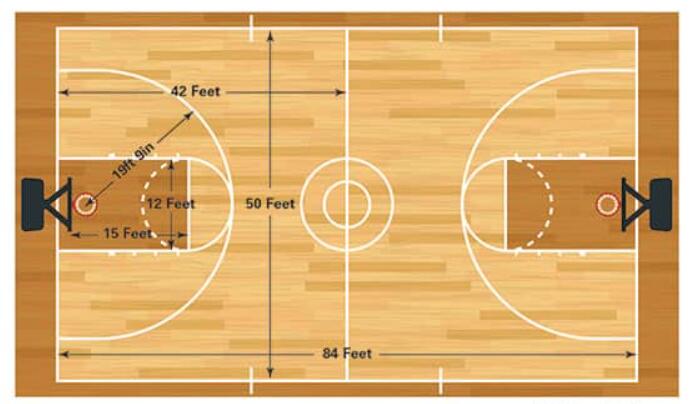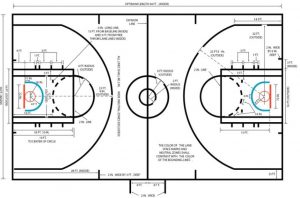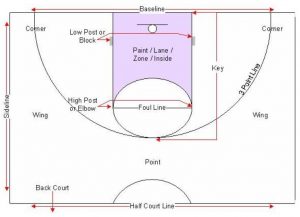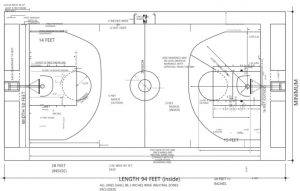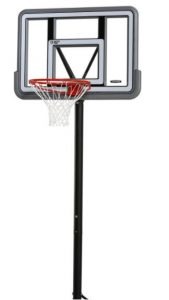The youth basketball court is different from the adult basketball court. It needs to be smaller in size, but some rules and standards need to be followed for the court to work well.
We will discuss things, like how is youth basketball court different from adult basketball court? What size of a youth basketball court should you use? How can you know the detailed dimension of each part on the youth basketball court? How do you determine your court size by relying on basic youth game rules and standards? And finally, how-to DIY your own youth basketball court with simple steps and cautions to take.
Let’s get started!
How Is Youth Basketball Court Different From Adult Basketball Court?
There are a few critical differences between youth and adult basketball courts. The first difference is the size of the court; youth courts are typically smaller than adult courts. This is because children need a shorter distance to run and have a lower vertical reach.
The second difference is that the hoop height is different in youth and adult courts. Youth hoops are lower than adult hoops; this makes it easier for smaller players to make a shot.
What Size of A Youth Basketball Court Should You Use?
The National Federation of State High School Associations (NFHS) has set out guidelines on how big the court should be and what basketball size should be used in high school leagues. We’ll cover full court dimensions, half-court dimensions, and international court dimensions.
Full Court Dimensions
Youth courts measure 42-feet wide and 74-feet long, whole high school courts measure 50-feet wide and 84-feet long.
Half Court Dimensions
The half-court measures 37 feet x 42 feet, while a high school half-court measures 42 feet x 50 feet.
International Court Dimensions
Full-court dimensions measure 104.9 feet x 62.3 feet in international competitions, while half-court dimensions measure 52 feet x 31 feet.
Are the High School Basketball Court And College Basketball Court the Same Size?
No, High school basketball court and college basketball court are different. The major difference is that the high school court is 10 feet shorter than its counterpart, measuring only 84 feet, while its width keeps 50 feet still.
Besides, in terms of 3-point-line, high school court measures 19 feet on the free-throw line and nine inches from the center of the basket.
To Know The Detailed Dimension Of Each Part On The Youth Basketball Court
Rim Height
6-foot rims for those in 1st grade and 2nd grade (kindergarten), and 8-foot rims for those between eight and ten years. The rim height is 9-foot rims for those in 5th grade and 10-foot basketball rims for those in grade six and above. Note that 10-feet is the height for most American/international kids, especially after entering middle school.
The primary consideration is training kids on the correct shooting form when setting the rim height. Based on the kid’s age, the common question is, can the child access the rim with proper shooting mechanics? Sadly, kids who can do this frequently lack the strength to get the basketball to a basketball rim located at higher heights for them. Therefore, they end heaving the basketball as they try making a basket because that’s the only option to reach a higher rim.
Click here to Check quality rim for youth safety in use.
Goal Height
An 8-foot goal height is recommended for kids between 7 and 8 years old. A 9-foot goal height is recommended for kids between 9 and 11 years old. Note that lower goal height for kids enhances shooting success and assists with making the correct shooting form.
Click here to get suitable goals designed for kids.
Lifetime adjustable basketball goal hoop is the proper one for youth between that age range, sturdy design with heavy-duty material on the backboard guarantees kids safety all the time. Check it here:
Basketball Size
Boys and girls between 9 and 11 years should use a basketball-size measuring 27.5 inches in circumference and weighing 17 ounces. These 27.5 inches basketballs are also identified as ‘size 5’ or ‘junior’ balls. The 27.5 inches circumference remains the most popular ball size with youth basketball leagues.
Check the youth use 27.5 inches basketball here:
Number of Players in Youth basketball courts
As per the youth basketball rules, only ten players can simultaneously participate on the basketball court. Therefore, the two teams participating can have utmost five players concurrently.
Determine Your Court Size Based on Basic Youth Basketball Game Rules & Standards
Game structure:
Youth basketball games are divided into four quarters that last approximately eight minutes.
Length of Game: You can also use the game’s length to determine court size for a youth basketball game. You can do this by multiplying the number of minutes in a quarter by four. So, an eight-minute match would require a court size that is 32 feet wide and 48 feet long.
Scoring: Another way to determine court size is by deciding how many points are needed to score to reach the end zone. The end zone should be located at each end of the court. If you have a youth basketball game where players can only score two points, your court size should be 24 feet wide and 36 feet long.
Timeout: Each team is allowed one timeout per half in terms of timeouts. The timeout can last for up to 60 seconds. Note that you can also use timeouts to determine court size. You can do this by deciding how many timeouts you will allow each team in your game. You can then use that number to select the size of your court and the end zone.
| Playing Segment | Game Length | Time Between Periods | Extra Periods(s) | Scoring |
| Age 7-8 | Four 8-minute periods | 1 minute | 2 minutes | Free throw: 1 point
All field goals: 2 points
No 3-point field goals |
| Age 9-11 | Four 8-minute periods | 1 minute | 2 minutes | Free throw: 1 point
All field goals: 2 points
No 3-point field goals |
| Age 12-14 | Four 8-minute periods | 1 minute | 4 minutes | Free throw: 1 point
All field goals: 2 points
Field goal outside of 3-point arc: 3 points |
| Age 9-12 | Four 10-minute periods | 2 minute | 5 minutes | Free throw: 1 point
All field goals: 2 points
Field goal outside of 3-point arc: 3 points |
Game tactics:
It can also guide you in determining the youth basketball court size.
Equal playing time: If you want to ensure that all players get equal playing time, you will need a larger court. This will give players more space to run and play.
Player-to-player vs. zone defense: If your team plays player-to-player defense, you will need more space on the court. The court size will need to be spacious to give players enough room to cover their opponents.
Pressing vs. no pressing: If your team presses the other team, you will need more space on the court. This will allow your players to trap the other team and force them into turnovers.
Gameplay rules:
It can also guide you in determining the youth basketball court size.
Use of a shot clock: The court will need to be spacious if you play with a shot clock. This allows players more time to get open shots and plan their moves without worrying about wasting too much time during any one possession of the game.
Substitutions: If your team is going to substitute (i.e., bring in substitutes) at specific points in the game, you will need to leave more space on the court for them. This gives players time to enter and exit the game without getting in each other’s way.
Clock stoppage: When the referee stops play (e.g., for a foul or out-of-bounds ball), they need a little extra time to make the call and stop play. This is why courts must be broader in these situations (e.g., fouls) than they would otherwise need to be – so that referees can get into position without disrupting game flow too much.
How to Arrange Your Own Youth Basketball Court Layout?
Now that you know the required dimensions for a youth basketball court, it’s time to set up your own layout. You’ll need to consider how many players will be on the court at any given time, as well as where the baskets will be positioned.
Here are some essential tips:
– If you have more than one player on a side, your court should be at least 28 feet wide.
– The baskets should be placed at least ten feet away from the sidelines and end lines.
– If you have more than one basket, make sure they’re positioned an equal distance apart.
– Make sure there’s plenty of space to run around the court.
– The half-court line should be parallel to the backboard, about four feet from it, so players can get a running start when making a jump shot.
DIY Your Youth Basketball Court with Simple Steps
Here, we’ll cover what you need and steps to make a youth basketball court without seeking outside help.
What you need:
– Tape measure
– Marker or chalk
– Level
Basic steps:
(Check the detailed court DIY instruction here.)
First, you need to measure the court dimensions and mark them with tape.
Second, use a level to make sure all lines are straight.
Third, use a marker or chalk to draw lines on the ground.
Finally, paint the lines if desired. If you don’t have time to do this, you can always hire a professional company to help you.
Take Cautions On These Things For Youth Safety In Use:
There are a few things to consider when building your youth basketball court.
- Make sure the surface is level and free of any obstructions.
- Use appropriate size boundaries for the age group playing.
- Avoid sharp or protruding objects in the playing area.
- Ensure that there is plenty of space around the court for spectators.
- Install a backstop or net to prevent balls from going out of bounds.
- Make sure the court is well-lit for evening play.
- Post some basic rules and regulations near the court so everyone knows how to play appropriately.
Takeaways
In conclusion, a youth basketball court can be a great addition to any backyard. When building it, make sure you consider the necessary dimensions and safety guidelines we have covered in this detailed blog post. Hesitate no more! With a little bit of planning, you can create a safe and fun-filled space for your kids (or even yourself) to enjoy!

